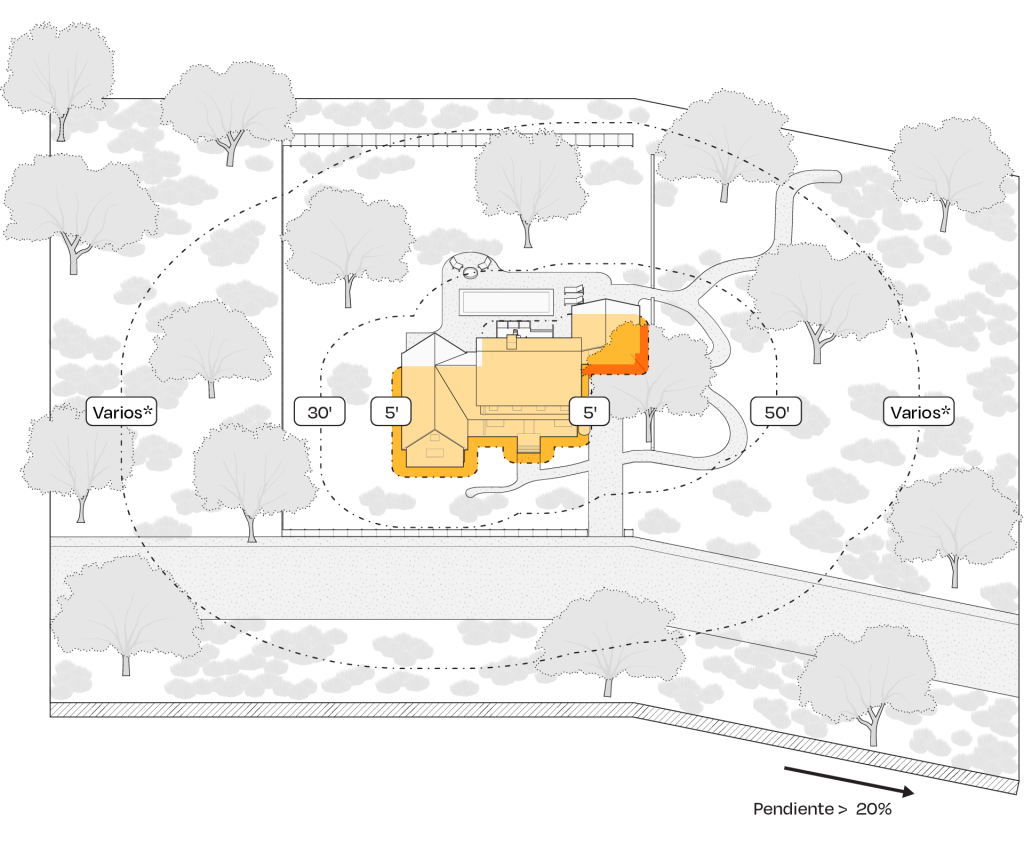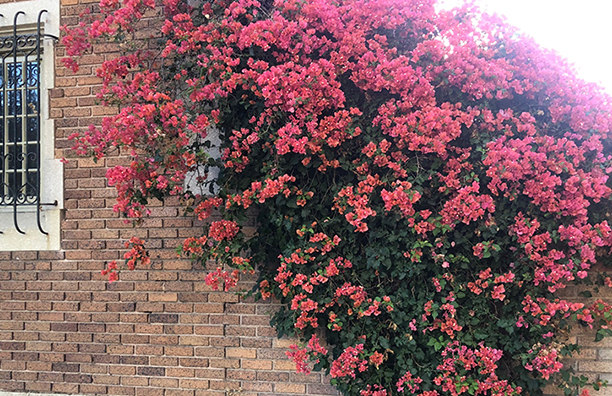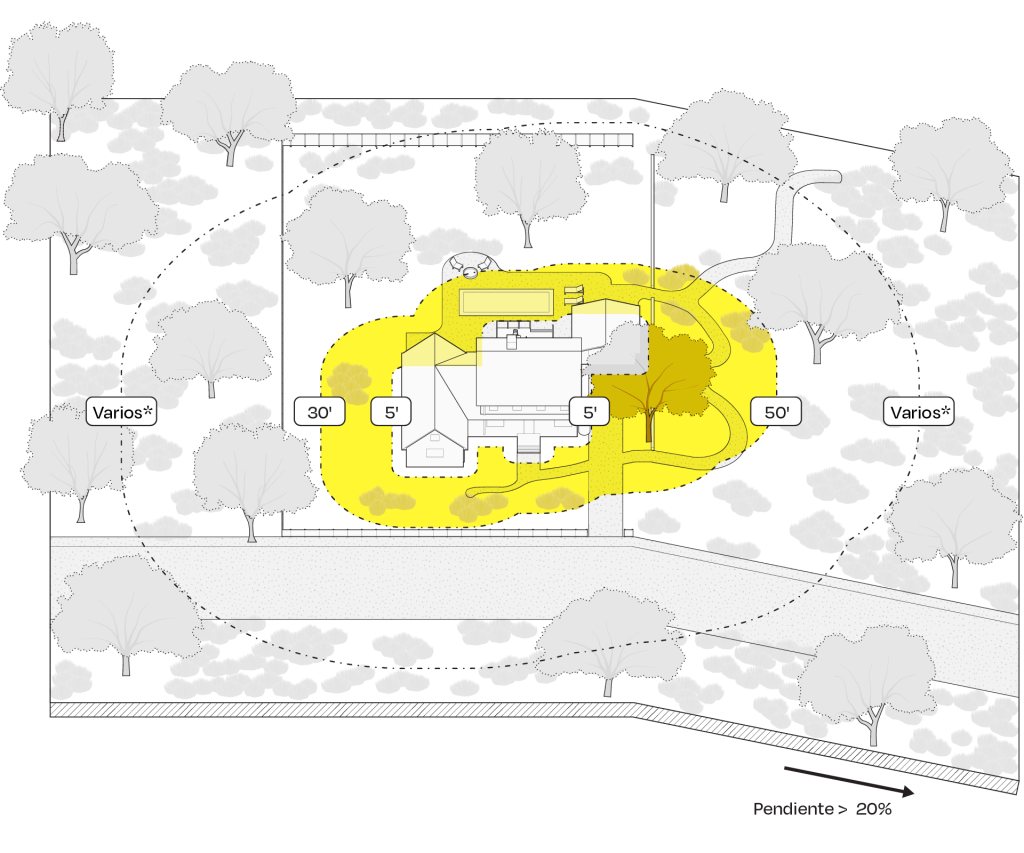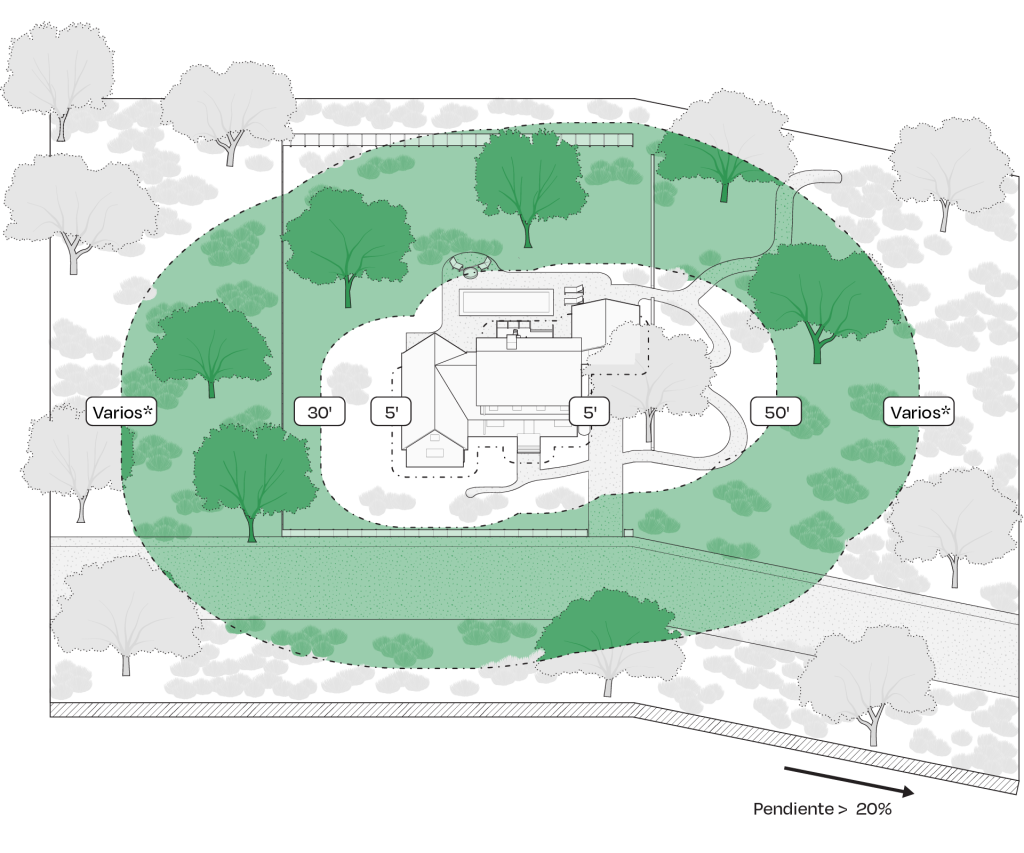LANDSCAPE (UPGRADE)
The Ember-Resistant Zone (ERZ)
This section provides information about important changes to make to your existing landscape to increase fire safety and reduce ignition risk. These recommendations apply to the Ember-Resistant Zone (5-foot distance) around your home.

* The size of the zones shown above are supported by research into home losses in wildfires, and are consistent with most local regulations at the time of publication. Based on this evidence and current CalFire standards, we show a maximum distance for native vegetation modification of 100′ from the house. However, the type of vegetation, terrain, and local regulations may require additional thinning beyond 100′. The Los Angeles County Fire Department may require up to 200’ of defensible space. Contact your local Fire Department for specific requirements.
Native vegetation is often protected by regulations, so do not remove previously unmodified habitat without first contacting your local County planning department for specific limitations and processes.
If you are neighboring a State Park or Protected Area, you may apply for a Boundary Vegetation Modification Right of Entry Permit (BVMROE) to address your desired defensible space. An approved permit allows homeowners or their contractor access to State Park land to trim vegetation within 130 feet of the closest habitable structure. To learn more about obtaining a State Parks BVMROE permit to complete defensible space for your home, contact California State Parks at info@parks.ca.gov.
Maintenance guidelines
 |
 |
Keep surrounding area of your structures clear of combustible materials |
||
 |
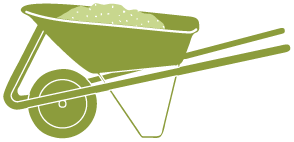 |
Replace combustible organic mulch with noncombustible products such as rocks and gravels |
||
 |
 |
Remove dead vegetation and implement maintenance strategy to keep the 5-foot zone clear of dead plant materials |
||
 |
 |
Keep surroundings and area under your deck clear of debris and flammable material |
||
 |
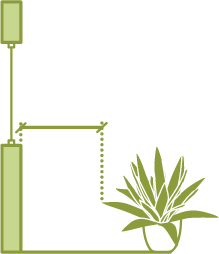 |
Include footprint of any attached structure, such as a deck, within the Ember-Resistant Zone |
||
 |
 |
Plants must be pruned back to prevent overhang onto any structure. Provide 5-foot breaks in horizontal continuity where appropriate (near the end of structures). |
Pruning Guideline
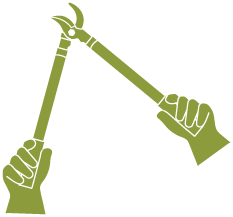 Prune trees to provide 5 feet of separation from the structure.
Prune trees to provide 5 feet of separation from the structure.
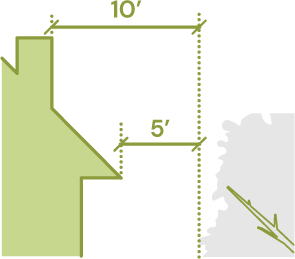 Prune back trees to provide a 5-foot minimum separation from the roof. Chimneys require a 10-foot separation.
Prune back trees to provide a 5-foot minimum separation from the roof. Chimneys require a 10-foot separation.
 Permitting may be required for pruning based on the species. Consult our Oak Woodland section for permitting regarding oak trees.
Permitting may be required for pruning based on the species. Consult our Oak Woodland section for permitting regarding oak trees.
Ornamental Vegetation
Some popular ornamental plants represent a very high risk of ignition and/or are known for generating very high temperatures that can ignite nearby structure through radiant heat (e.g. Italian cypress). Remove or follow guidelines for any of the following plants if they are present in your Ember-Resistant Zone. Additionally, many of those species are invasive.
The Home Protection Zone
The Home Protection Zone should be designed to create and maintain a landscape that, if ignited, will not transmit fire to the home. Depending upon the type of wildland vegetation in the area and the steepness of the slope, this zone should have an area at least 30 feet wide (50 feet for slopes above 20%) that is lean, clean, and green.
If you are rethinking your home landscape for greater fire resilience, we encourage you to consider native plants. Natural ecosystems of the Wildland Urban Interface are often threatened and under pressure from increasing development. By incorporating native plants into your landscapes, you can help extend habitat and conserve the beauty that likely brought you to the area in the first place.
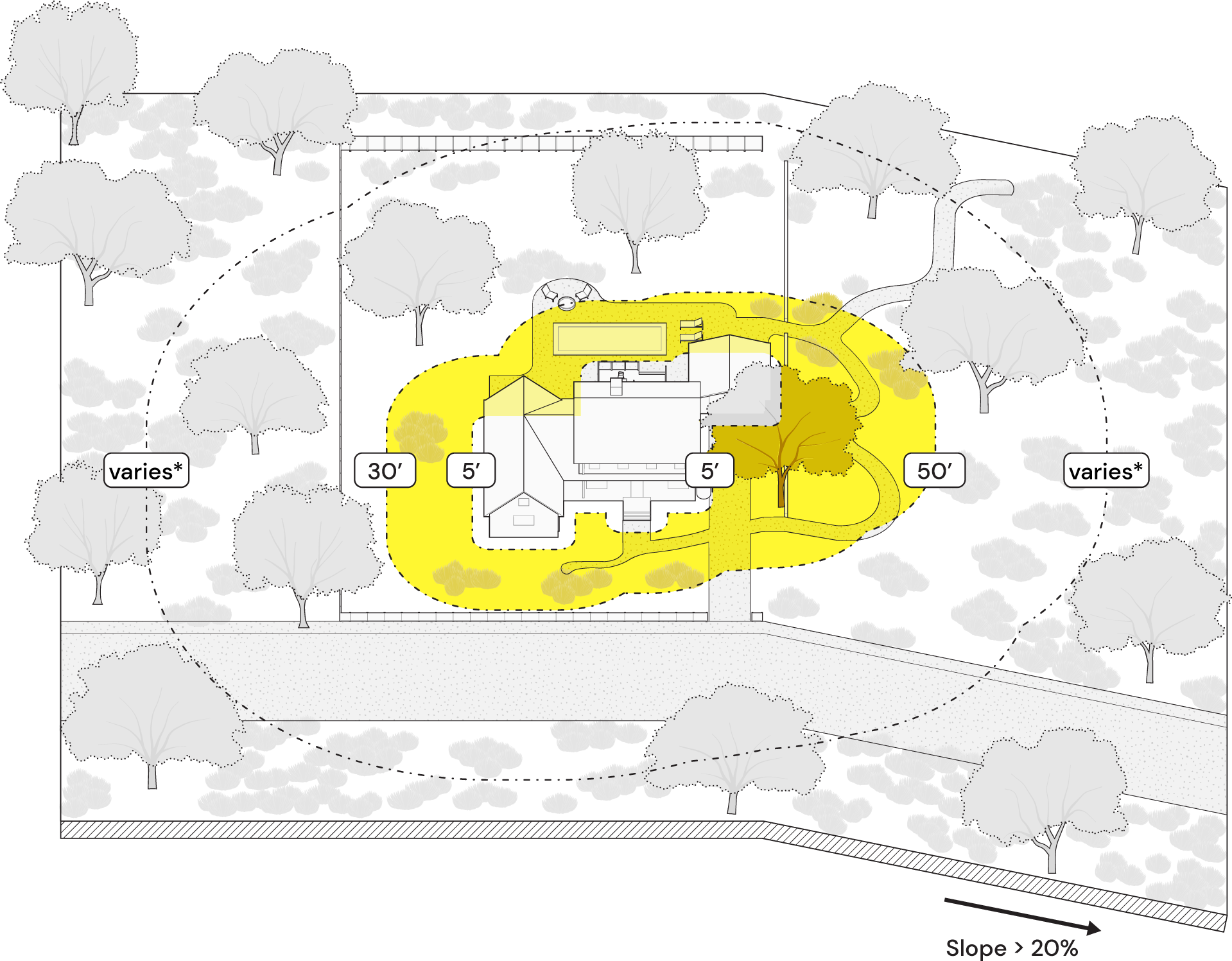
* The size of the zones shown above are supported by research into home losses in wildfires, and are consistent with most local regulations at the time of publication. Based on this evidence and current CalFire standards, we show a maximum distance for native vegetation modification of 100′ from the house. However, the type of vegetation, terrain, and local regulations may require additional thinning beyond 100′. The Los Angeles County Fire Department may require up to 200’ of defensible space. Contact your local Fire Department for specific requirements.
Native vegetation is often protected by regulations, so do not remove previously unmodified habitat without first contacting your local County planning department for specific limitations and processes.
If you are neighboring a State Park or Protected Area, you may apply for a Boundary Vegetation Modification Right of Entry Permit (BVMROE) to address your desired defensible space. An approved permit allows homeowners or their contractor access to State Park land to trim vegetation within 130 feet of the closest habitable structure. To learn more about obtaining a State Parks BVMROE permit to complete defensible space for your home, contact California State Parks at info@parks.ca.gov.
Seasonal Maintenance
To maintain a fire-wise landscape year-long, consult our section on Seasonal Maintenance.
Maintenance Guidelines
If you already have an established landscape but you’re considering changes to the vegetation in your Zone 1, follow these simple guidelines:
 |
 |
Plan your landscape as vegetation islands separated by non-combustible pathways or hardscape features. Check the NEW tab for more information about spacing. |
||
 |
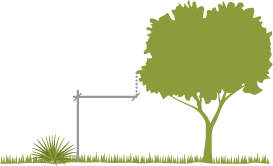 |
Prevent trees and large shrubs from touching each other or hanging over structures (CAL FIRE currently instructs spacing of at least 10 feet.) |
||
 |
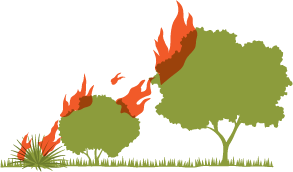 |
Remove “laddering” plants that can spread a ground fire up to a tree’s crown. |
||
 |
 |
Remove dead or dying trees. |
||
 |
 |
Break up continuous, flammable ground cover (e.g., grasses, mulch) with hardscaping and other fire-resistant features. Learn more about fire-resistant plants. |
||
 |
 |
Provide good access to water within 30 feet of your home. Learn more about irrigation. |
The Thinning Zone
The Thinning Zone has a dual function. It serves as a connection with the natural environment promoting habitat restoration while eliminating continuous, dense vegetation, to decrease the energy and speed of the wildfire. The Thinning Zone supports habitat connectivity and wildfire discontinuity. Do NOT remove vegetation down to bare soil, and do not destabilize hillsides by using heavy equipment; soil erosion and mudslides can result.
If you are rethinking your home landscape for greater fire resilience, we encourage you to consider native plants. Natural ecosystems of the Wildand Urban Interface are often threatened and under pressure from increasing development. By incorporating native plants into your landscapes, you can help extend habitat and conserve the beauty that likely brought you to the area in the first place.

* The size of the zones shown above are supported by research into home losses in wildfires, and are consistent with most local regulations at the time of publication. Based on this evidence and current CalFire standards, we show a maximum distance for native vegetation modification of 100′ from the house. However, the type of vegetation, terrain, and local regulations may require additional thinning beyond 100′. The Los Angeles County Fire Department may require up to 200’ of defensible space. Contact your local Fire Department for specific requirements.
Native vegetation is often protected by regulations, so do not remove previously unmodified habitat without first contacting your local County planning department for specific limitations and processes.
If you are neighboring a State Park or Protected Area, you may apply for a Boundary Vegetation Modification Right of Entry Permit (BVMROE) to address your desired defensible space. An approved permit allows homeowners or their contractor access to State Park land to trim vegetation within 130 feet of the closest habitable structure. To learn more about obtaining a State Parks BVMROE permit to complete defensible space for your home, contact California State Parks at info@parks.ca.gov.
Seasonal Maintenance
To maintain a fire-wise landscape year-long, consult our section on Seasonal Maintenance.
Maintenance Guidelines
If you already have an established landscape but you’re considering changes to the vegetation in your Zone 2, follow these simple guidelines:
 |
 |
Keep your yard clear of trash, natural debris, and dried grasses. |
||
 |
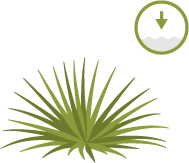 |
The vegetation in Zone 2 is likely to be outside your irrigation zone. Use low-maintenance plants that require low water and pruning. |
||
 |
 |
Clear dead and diseased plants. Learn more about sustainable pest management in our dedicated section. |
||
 |
 |
Create both horizontal and vertical spacing between plants. Avoid laddering understory plants; space trees and shrubs at one or two times their mature height. Learn more about proper spacing in the NEW tab of this section. |
||
 |
 |
Maintain proper spacing by periodically re-opening gaps between plants as they grow closer together. |
||
 |
 |
Consider expanding this zone up to 200 feet for steep slopes with flammable shrubs. |
Sources
California Native Plants for The Garden (2006) by C. Bornstein, D. Fross, and B. O’Brien. Cachuma Press.
California Watershed Approach to Landscaping (G3, 2018)
California Friendly Guide to Native and Drought Tolerant Gardens (Las Virgenes Municipal Water District, 2009)
Compost in a Hurry (UC ANR, 2007)
Defensible Space, Fire Retardant Landscaping, and Fire Hazard Reduction (UC ANR, 2020)
Fire Preparation Through the Year (UC ANR, 2020)
Fire Recovery Guide (California Native Plant Society, 2019)
Getting Started with Native Plants (Theodore Payne Foundation, 2015)
Mowing Your lawn and “Grasscycling” (UC ANR, 1999)
Native Planting Guides (California Native Plant Society)
Pruning Tips and Techniques (California Native Plant Society)
Roadmap to Fire Safety (SMMFSA, 2010)
S.A.F.E. Landscapes – Southern California Guidebook (UC ANR, 2009)
Starting a Native Plant Garden (California Native Plant Society, 2017)

